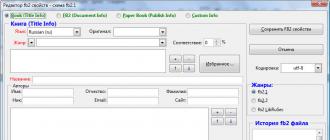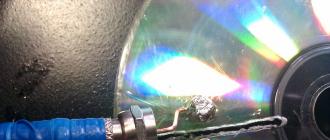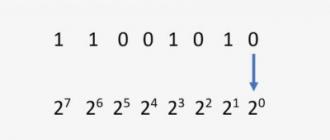Selecting a cellular signal booster. GSM cellular communication booster system
1. Installation of an external antenna.
The first step is installation external antenna. The antenna is installed using fasteners (a swivel bracket or a mast) on the external wall of the building or on the roof, depending on the location.
The specialist determines the direction in which the antenna will be directed, since the incoming signal from different telecom operators must be the same, or the signal of any particular operator must predominate if the goal was to improve the quality cellular signal only one operator.
2. Preparation and crimping of the cable.
.jpg) At the ends of the prepared cable, you need to put on N-type connectors and crimp them (or prepare the cable in advance and solder the connector if it does not involve crimping). We recommend protecting the connector with heat shrink or tape, as it can oxidize over time, causing erratic operation and interference. Next, we connect our cable to the external antenna and move on to the next step.
At the ends of the prepared cable, you need to put on N-type connectors and crimp them (or prepare the cable in advance and solder the connector if it does not involve crimping). We recommend protecting the connector with heat shrink or tape, as it can oxidize over time, causing erratic operation and interference. Next, we connect our cable to the external antenna and move on to the next step.
3. Cable laying.
Everyone knows that when laying a cable, it is very important that the distance from the repeater to the external antenna should be minimal, since with a long cable there will be large signal losses (the amplitude of the incoming signal should be maximum). We choose a place for laying the cable, taking into account all the recommendations, lay it and proceed to repeater installation(amplifier cellular communication).
4. Installation of a cellular signal amplifier.
.jpg) The installation location of the repeater is selected based on the minimum length of the cable and so that it is not located in a visible place. This can be either an attic, if it is a private house, or the repeater is hidden above the ceiling, if it is an office building. But you need to make sure that the installation location complies with the permitted climatic conditions in the repeater’s passport.
The installation location of the repeater is selected based on the minimum length of the cable and so that it is not located in a visible place. This can be either an attic, if it is a private house, or the repeater is hidden above the ceiling, if it is an office building. But you need to make sure that the installation location complies with the permitted climatic conditions in the repeater’s passport.
5. Connecting an external antenna to the amplifier.
There are two connectors on the cellular repeater body. We will need a connector, which is designated by the letters BS - this is the amplifier input. We connect our cable from the external antenna, making sure that the connector is screwed in tightly and all the way.
6. Installation of the internal antenna.
.jpg) Depending on the situation and the area of the object, internal antennas maybe several.
Depending on the situation and the area of the object, internal antennas maybe several.
If several antennas will be used, then it is necessary to install a signal splitter that will divide the power for each antenna. Next, you need to crimp the cable with connectors, as was done in the beginning, and connect it to the signal splitter and to the internal antennas. Signal splitter connect in a similar way to the second, free output of the amplifier. If only one internal antenna was used, it is connected directly to the repeater.
Is it necessary to purchase an expensive gadget when you can get by with a device assembled from improvised materials?
Those who have at least First level knowledge in the field of cellular communications will be able to cope on their own. To do this, you need components and tools, as well as a diagram of the device.
And you can assemble a simple cellular communication amplifier on your own. What is required for this will be discussed below.
Antennas for amplifying cellular communications
They are one of the simplest devices that allow you to achieve a high-quality signal at any object.
 There are two main groups of antennas:
There are two main groups of antennas:
- External;
- Internal.
The former are usually installed on the roof of a building and are capable of providing coverage over large areas. The antenna transmits the signal received from the base station through a cable to the amplifier. This guarantees good communication quality even in areas where it was previously impossible.
What elements does the signal amplification system consist of?
It is possible to ensure reliable communication in places that are difficult to reach for a radio signal, but this will require special equipment. Collected in unified system Various devices allow you to achieve high signal quality and forget forever about its sudden loss. It is often called a cellular booster. However, in reality it is a complex consisting of the following elements:
- A repeater or two-way amplifier, which is an intermediate link;
- External and internal antennas that pick up the station signal and distribute it indoors;
- Power divider or wire splitter;
- N-connectors;
- Coaxial cable with a resistance of 50 Ohms.
All devices included in the system are divided into two groups:
- Active;
- Passive.
The first includes devices that require a connection to a power source to operate - this is a repeater, connectors. Antennas, divider and cable are called passive. Each system is designed for a specific object and therefore may have a different number of amplifiers and internal antennas. The best option is considered to be one that uses a cable of minimal length, since every extra meter is a loss in signal quality. This must be taken into account when assembling a cellular signal amplifier with your own hands.
Since all the elements are interconnected, it is recommended to install the equipment before finishing, so as not to spoil the interior.
Repeater operating principle
Equipment of this class is in some way a repeater. It processes received signals and sends them to the base station tower if it is an outgoing call. When a subscriber is dialed, the repeater performs the same function, only the connection is made with the user’s gadget.
Let's watch the video, the simplest way boost the signal:
Signal reception and transmission is carried out by antennas. The simplest signal amplifier cellular network can be assembled with your own hands. The outdoor antenna receives or sends it to the station, and the indoor antenna is responsible for expanding the coverage area indoors.
How to make a cellular booster with your own hands
Using such a device allows you to achieve high-quality communication in almost any corner of the facility. A repeater is especially necessary in areas with poor signal or where there is no signal. The advantages of using the system include the following:
- Strengthening the signal in places where there are frequent interruptions in mobile communications;
- Removing interference;
- Increased message clarity;
- Reduced radiation levels;
- Longer phone battery life.
But since such equipment is not cheap, many decide to make it themselves.
Let's watch the video, the stages of making it yourself:
In order to assemble a cellular communication amplifier on your own, you will need components that need to be connected into a single system. How to do this will be discussed further.
What is needed for assembly
 If you decide to make the simplest device, namely an antenna, then you will need:
If you decide to make the simplest device, namely an antenna, then you will need:
- Wire, but not copper (length 30-40 cm);
- Connection block;
- Cable (up to 10 m);
- Fasteners (for mounting connecting blocks);
- Polymer pipe (20 cm);
- Plastic.
Since during the work you will have to connect individual elements, it is worth having electrical tape on hand. After all the components have been found and prepared, you can begin assembling the cellular signal amplifier with your own hands.
A piece of wire must be bent in the middle by 90°, so that the end result is a rhombus. To do this, retreat 9 cm from the center in both directions. Then, at the mark, the wire is again bent to the same angle. As a result of the manipulations performed, you get a rhombus. The ends are bent inward and a block is connected to them. Install it so that future connections can be made through it. To do this, cut along one side of the polymer pipe and make a hole on the opposite side.
Watch the video and make an amplifier from cans:
After the antenna assembly stage has been completed, we begin to connect the coaxial cable. At one of its ends, the outer insulation is removed and the outer and inner conductors are connected to the contacts of the connecting block. As a result, the cable becomes an extension of the antenna.
After this, all that remains is to install the device on the roof of the house or attach it to a pole and point it towards the base station mobile operator. The last stage in the manufacture of a simple amplifier with my own hands is to connect the other end of the cable to a plastic plate. And you can start testing.
If everything was done correctly, then as soon as you bring mobile phone to the amplifier, the signal indicator will increase by 2 or 3 divisions.
Selecting a repeater installation location
But it’s not enough just to assemble a cellular communication amplifier, you also need to install it correctly. The efficiency of such equipment is directly dependent on its location, as well as the antennas included in the system. Therefore, before proceeding with installation, you must make sure that the signal level is sufficient. The easiest way to find out is by making a call from your phone where you plan to install the antenna. You can also determine the signal level by the indicator on the gadget’s display.

Antenna installation
But besides this, there are other restrictions. For example, the place to install the amplifier should not be closer than a meter to heating appliances.
After planning the location of all components, begin laying the coaxial cable. But before turning on the repeater, you need to make sure that all connectors are intact and clean. Do not turn on the device if it is not connected to an external antenna, as it may be damaged. If you need to disconnect the RF cables, be sure to turn off the power.
There are also restrictions in temperature conditions. If for an external antenna it ranges from -40 to +50°C, then for the repeater itself it is limited only to positive temperatures. In addition, the repeater can only be installed in a heated room.
We must remember! An incorrectly assembled system can emit interference, which affects the operation of nearby stations. Therefore, you should not install it without examining the site and determining the location for all the blocks.
Amplifier settings
In order to obtain a stable and sufficiently strong communication signal at a specific facility, it is necessary to correctly perform all commissioning work. They consist of quality adjustment voice messages and eliminating self-excitation of the device.
We watch the video, what to do if the signal is bad, we look at the solutions:
The first thing to start with is to make sure that all connections are intact. The power adapter and antennas are connected to the high-frequency connectors. If power surges frequently occur in the network, then it is necessary to use a surge protector.
The next step is to adjust the gain. It must be at least 15 dB. The repeater can be configured manually or automatically. In the first case, adjustment is carried out using the potentiometer knob and changing the position of the external and internal antennas.
Automatic tuning involves setting the gain level so that maximum output power is obtained. In this case, the device will independently adapt to the traffic of the operator’s base station.
The presented calculation of a cellular communication amplification system will confirm the correctness of the selection of equipment and the installation of cellular signal amplifiers.
As an example, let's take the simplest case of a mobile voice amplification system.
Initial data
First we need to determine the initial data:
- Frequency range in which we receive the signal
- The signal level in the place where the external antenna will be or has already been installed. To measure the signal level, we need a simple phone, namely the Netmonitor service function.
Phone service functions
You can read about what code you need to dial on your phone model in the article “Service functions of phones”.
For smartphones on Android platform even simpler. There are many for them free applications in order to find out the input signal level of the received station, as well as other useful information, such as Network Code (MNC), Base Station Number (BSIC), Cell ID and more.
We have got it at our disposal samsung smartphone GT-S5250.
| We dial the code *#9999*0# and immediately get to the phone menu service. | |
| Press “Back” several times in a row until the phone returns to the main menu. | |
| Select the first item “Debug Screen”, enter “1” on the virtual keyboard that appears. | |
| Next, we also enter “1”, thereby selecting “Basic Mode Information”. |
And we get all the necessary information and even unnecessary information. IN this phone A Megafon SIM card was installed.
- RPLMN: 250 -02
- 250 - country code (250 - Russia, 255 - Ukraine, 257 - Belarus);
- 02 - network code (01 - MTS, 02 - Megafon, 99 - Beeline, 20 - Tele2);
- GSM 900- standard mobile communications, in which the phone is currently working;
- BSIC: 19- code of the BS from which this moment a signal is received;
- BcchFrq: 102- the number of the Base Station channel on which communication is currently taking place; for more information about the channels and their distribution by operator, read the article “The principle of operation of cellular communications”. Indeed, channel 102 in St. Petersburg is used by Megafon and is in the GSM 900 band;
- RSSI: -63- received signal level in dBm;
- RxLev: 47- the level of the same signal, but in other conventional units, the higher its value, the better the signal.
So let’s assume that the signal level was measured at the location where the external antenna was installed, and the signal needs to be amplified in a small basement room with an area of 40 m². We will carry out the calculation for the DownLink direction (signal from the base station to the mobile phone).
Selected equipment
| AL-900-11 external antenna, directional, “wave channel” type, with gain Ku=11 dB | PicoCell 900 SXB repeater with gain Ku=60 dB and output power up to P=10 mW | AP-800/2700-7/9 ID internal panel antenna with gain in the frequency range 900 MHz - Ku=60 dB | with a short length of strong signal attenuation it will not introduce |

|

|

|
The scheme of the mobile communication amplification system will be as follows:

The calculation method is as follows:
- We measured the signal level with the phone at the point where the external antenna was pre-installed: -63 dBm. The antenna gain is 11 dB, respectively, at the antenna output we have a signal of -63 + 11 = -52 dBm.
- Every cable has its own RF characteristics. For example, for our 5D-FB cable, 19.7 dB is lost at 100 meters at 900 MHz (see technical specifications). The higher the signal frequency, the greater the cable loss. Accordingly, at 10 meters about 2 dB will be lost. Thus, a signal of -52 -2 = -54 dB arrives at the repeater input.
- We look at the repeater gain in its technical specifications(in our case, the 900SXB has Ku = 60 dB). We get at the amplifier output: -54 +60 = +6 dBm.
- In a cable from the repeater to the internal antenna over a length of 5 meters, the loss will be approximately 1 dB.
Thus, the signal +6 -1 = +5 dBm arrives at the input of the internal antenna. - The gain of the AP-800/2700-7/9 ID antenna at a frequency of 900 MHz is Ku=7 dB. Thus, the antenna will emit a signal with a level of +5 +7= + 12 dBm.

In order to convert the signal level from dBm to mW, we use the formula: P[mW] =10^(0.1* P[dBm]). In our case: P[mW] =10^(0.1*12)=15.8 mW.
In order to estimate the coverage area and not carry out complex mathematical calculations of signal attenuation in space, based on experimental data it has been established that if the signal level in mW is multiplied by a factor of 4 for the 900 MHz range (for the 1800 MHz range - by a factor of 3), then it is possible obtain the approximate coverage area in m². If there are walls and partitions, the area may be significantly smaller.






